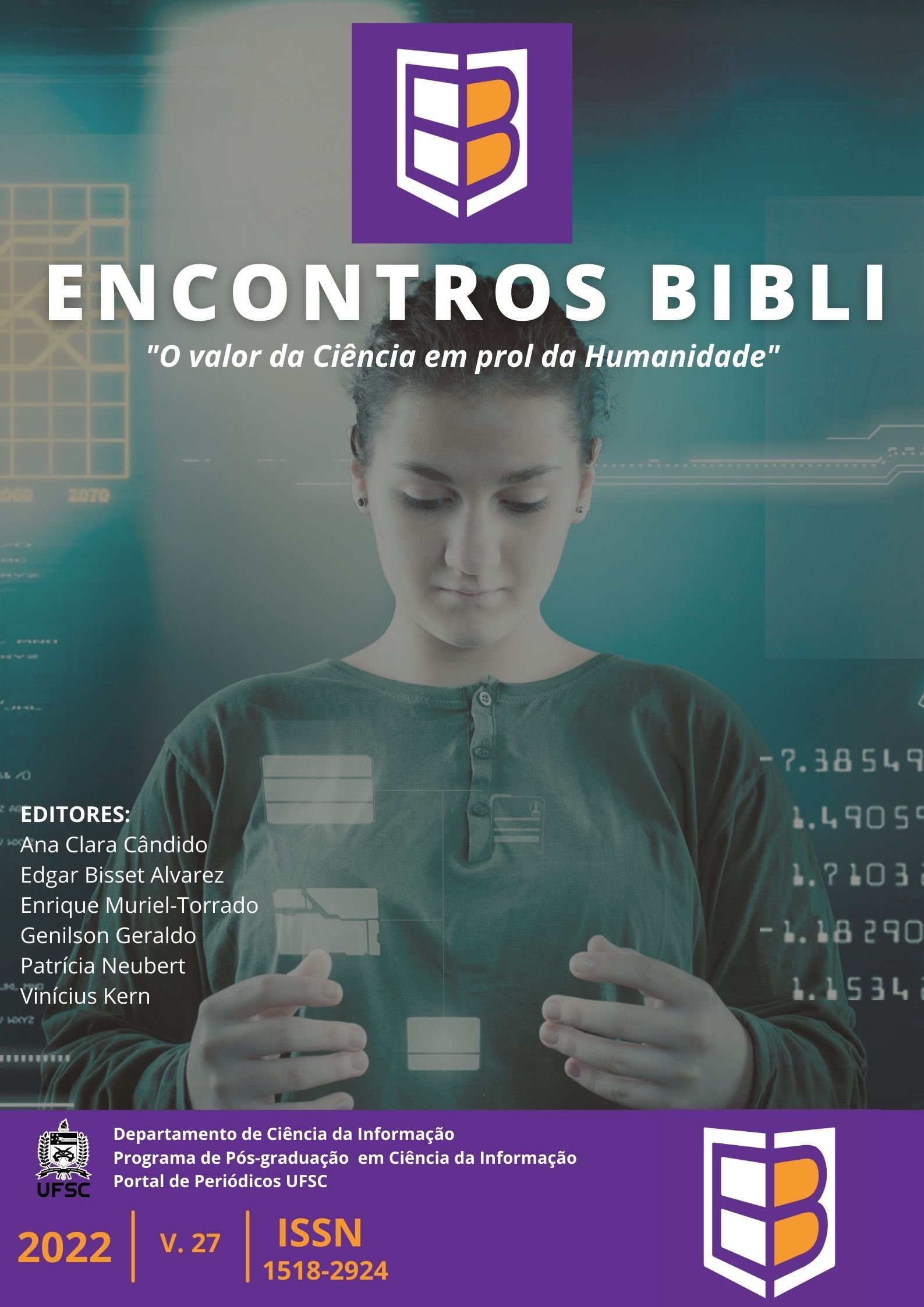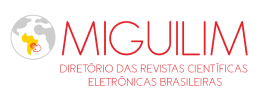Brazilian collaboration with australian, canadian, united states and uk authors and the performance of universities in the ARWUGRAS ranking
DOI:
https://doi.org/10.5007/1518-2924.2022.e84306Keywords:
Scientific collaboration, Citation analysis, Corresponding author, Brazilian universities, University rankings, ARWUGRASAbstract
Objective: identify the Brazilian disciplines and universities that benefit from scientific collaboration with Australia, Canada, the United States and the United Kingdom, visualized based on their performance in the Global Ranking of Academic Subjects (ARWUGRAS).
Method: exploratory study that identified Brazilian papers indexed in InCites between 2010-2019, and recalculated weights for articles in collaboration with the four English-speaking countries. InCites data were compared with the performance of Brazilian universities present in the 54 disciplines of ARWUGRAS edition 2021.
Results: Brazil figures in 39 of the 54 ARWUGRAS disciplines, with the presence of 49 different Brazilian universities. When papers in international collaboration with English-speaking countries was removed, there was a change in the position of Brazilian universities in the ranking list. Statistical tests demonstrate a significant advantage for collaboration with these countries, considering all disciplines together. When specifically tested by large areas, it was observed that there is no significant gain for Engineering and Life Sciences, but there are significant results for the advantage presented by Natural Sciences and Health Sciences.
Conclusion: the analysis of the performance of Brazilian universities in the ARWUGRAS showed that there is an advantage in their positioning when there is collaboration with authors from Australia, Canada, the United States and the United Kingdom.
Downloads
References
BEAVER, D.B.; ROSEN, R. Studies in scientific collaboration: part I – the professional origins of scientific co-authorship. Scientometrics, Dordrecht, v. 1, n. 1, p. 65-84, 1978.
BORDONS, M.; GONZÁLEZ-ALBO, B.; APARICIO, J.; MORENO, L. The influence of R&D intensity of countries on the impact of international collaborative research: evidence from Spain. Scientometrics, Dordrecht, v. 102, p. 1385-1400, 2015.
CHINCHILLA RODRIGUEZ, Z.; LARIVIÈRE, V.; ROBINSON GARCIA, N.; SUGIMOTO, C. Building ties across countries: international collaboration, field specialization, and global leadership. Proceedings of the 23rd International Conference on Science and Technology Indicators, 12-14 September 2018, p. 1509-1518.
CHINCHILLA-RODRÍGUEZ, Z.; SUGIMOTO, C.; LARIVIÈRE, V. Follow the leader: On the relationship between leadership and scholarly impact in international collaborations. PLoS ONE, San Francisco, v. 14, n. 6, 2019, e0218309.
GONZÁLEZ-ALCAIDE, G.; PARK, J.; HUAMANI, C.; RAMOS, J.M. Dominance and leadership in research activities: collaboration between countries of differing human development is reflected through authorship order and designation as corresponding authors in scientific publications. Plos One, San Francisco, August 8, 2017.
GRÁCIO, M. C. C. et al. Does corresponding authorship influence scientific impact in collaboration: Brazilian institutions as a case of study. Scientometrics, Dordrecht, v. 125, p.1349–1369, 2020.
HAEFFNER, C.; ZANOTTO, S.R.; GUIMARÃES, J.A. Internacionalização da universidade brasileira. Desafios e perspectivas na busca pelo padrão de universidade de classe mundial. RBPG, Brasília, v. 17, n. 37, jan./jun. 2021.
HAIR, J.F.; ANDERSON, R.; TATHAM, R.L.; BLACK, W.C. Análise multivariada de dados. Porto Alegre: Bookman, 2005.
LANCHO BARRANTES, B.S. et al. Citation flows in the zones of influence of scientific collaboration. Journal of the American Society for Information Science and Technology, New York, v. 63, n. 3, p. 481-489, 2012.
KAYCHENG, S. Multicolinearity and Indicator Redundancy Problem in World University Rankings: an example using Times Higher Education World University Ranking 2013–2014 Data. Higher Education Quarterly, Oxford, v. 69, n. 2, p. 158-174. 2015.
LEAL, F.G.; STALLIVIERI, L.; MORAES, M.C.B. Indicadores de internacionalização: o que os rankings acadêmicos medem? Revista Internacional de Educação Superior, Campinas, v. 4, n. 1, p. 52-73, jan./abr. 2018.
MAN, J.P.; et al. Why do some countries publish mores than others? An international comparison of research funding, English proficiency and publication output in highly ranked general medical journals. European Journal of Epidemiology, New York, v. 19, p. 811-817, 2004.
MOYA ANEGÓN, F.; GUERRERO BOTE, V. P.; BORNMANN, L.; MOED, H. F. The research guarantors of scientific papers and the output counting: a promising new approach. Scientometrics, Dordrecht, v. 97, p. 421-434. 2013.
MOYA-ANEGÓN, F. et al. Statistical relationships between corresponding authorship, international co-authorship and citation impact of national research systems. Journal of Informetrics, Amsterdam, v. 12, p. 1251-1262, 2018.
ROBINSON-GARCIA, N.; TORRES-SALINAS, D.; Herrera-Viedma, E.; DOCAMPO, D. Mining university rankings: Publication output and citation impact as their basis. Research Evaluation, Oxford, v. 28, n. 3, p. 232–240. 2019.
SMITH, M. The trend toward multiple authorship in Phychology. American Psychologist, Washington, v. 13, p. 596-599, 1958.
SCHMOCH, U.; SCHUBERT, T. Are international co-publications an indicator for quality of scientific research? Scientometrics, Dordrecht, v. 74, n. 3, p. 361-377, 2008.
SHANGHAI RANKING. Shanghai Rankin´s Academic Ranking of World Universities. 2021. Disponível em: https://www.shanghairanking.com/rankings/arwu/2021 . Acesso em: 07 set. 2021.
SOLLA PRICE, D.J. O Desenvolvimento da Ciência: Análise histórica, filosófica, sociológica e econômica. Tradução de Simão Mathias com a colaboração de Gilda Maria Braga. Rio de Janeiro: Livros Técnicos e Científicos, 1976. 73 p. Tradução de: Little science, big science.
TARKANG, E. E.; KWEKU, M.; ZOTOR, F. B. Publication practices and responsible authorship: a review article. Journal of Public Health in Africa, Pavia, v. 8, N. 723, 2017.
VAN LEEUWEN, T.N. Strength and weakness of national science systems: a bibliometric analysis through cooperation patterns. Scientometrics, Dordrecht, v. 79, n. 2. p. 389-408, 2009.
VANZ, S.A.S. et al. Rankings universitários internacionais e o desafio para as universidades brasileiras. Encontros Bibli: revista eletrônica de biblioteconomia e ciência da informação, Florianópolis, v. 23, n. 53, p. 39-51, set./dez., 2018.
VANZ, S.A.S. O que medem os rankings universitários internacionais? apontamentos teóricos, indicadores e características. Informação & Sociedade: Estudos, João Pessoa, v. 28, n. 2, 2018.
VIEIRA, R.C.; LIMA, M.C. A busca pelo selo “universidade classe do mundo” e os rankings acadêmicos globais pioneiros. Interfaces Brasil/Canadá, Pelotas, v. 16, n. 1, p. 97-116, 2016.
WAGNER, C.S. The new invisible college. Washington: Brookings Institution Press. 2008. 157 p.
WOUTERS, P. et al. The Metric Tide: Literature Review (Supplementary Report I to the Independent Review of the Role of Metrics in Research Assessment and Management). HEFCE. 2015.
ZHIGANG, H. et al. Mapping research collaborations in different countries and regions: 1980-2019. Scientometrics, Dordrecht, v. 124, p. 729-745, 2020.
XIAOJUN, H.; ROUSSEAU, R.; JIN, C. In those fields where multiple authorship is the rule, the h-index should be supplemented by role-based h-indices. Journal of Information Science, London, v. 36, n. 1, p. 73-85, 2010.
Published
How to Cite
Issue
Section
License
Copyright (c) 2022 Samile Andrea de Souza Vanz, Domingo Docampo

This work is licensed under a Creative Commons Attribution 4.0 International License.
The author must guarantee that:
- there is full consensus among all the coauthors in approving the final version of the document and its submission for publication.
- the work is original, and when the work and/or words from other people were used, they were properly acknowledged.
Plagiarism in all of its forms constitutes an unethical publication behavior and is unacceptable. Encontros Bibli has the right to use software or any other method of plagiarism detection.
All manuscripts submitted to Encontros Bibli go through plagiarism and self-plagiarism identification. Plagiarism identified during the evaluation process will result in the filing of the submission. In case plagiarism is identified in a manuscript published in the journal, the Editor-in-Chief will conduct a preliminary investigation and, if necessary, will make a retraction.
This journal, following the recommendations of the Open Source movement, provides full open access to its content. By doing this, the authors keep all of their rights allowing Encontros Bibli to publish and make its articles available to the whole community.
Encontros Bibli content is licensed under a Creative Commons Attribution 4.0 International License.
Any user has the right to:
- Share - copy, download, print or redistribute the material in any medium or format.
- Adapt - remix, transform and build upon the material for any purpose, even commercially.
According to the following terms:
- Attribution - You must give appropriate credit, provide a link to the license, and indicate if changes were made. You may do so in any reasonable manner, but not in any way that suggests the licensor endorses you or your use.
- No additional restrictions - You may not apply legal terms or technological measures that legally restrict others from doing anything that the license permits.

























